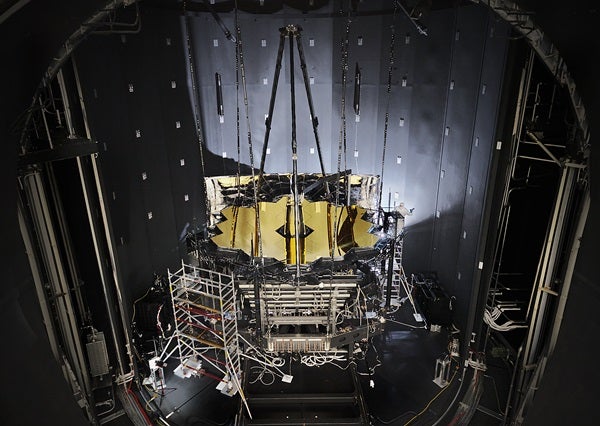Launching a project of this size and scope will be an amazing achievement, but it is not without its challenges. Each part of the observatory must undergo rigorous testing, often both separately and once integrated into the whole, before it can be considered fit for launch. This is the main reason for the additional delay, said acting NASA Administrator Robert Lightfoot in a press release today: “All the observatory’s flight hardware is now complete, however, the issues brought to light with the spacecraft element are prompting us to take the necessary steps to refocus our efforts on the completion of this ambitious and complex observatory.”
Testing is extremely important for any observatory, but this one perhaps more so than previous projects. Unlike the Hubble Space Telescope, which was placed in Earth orbit and accessible for repairs and upgrades, JWST will share Earth’s orbit around the Sun from a point called L2. This position, about 1 million miles (1.5 million kilometers) away, will help to keep the telescope cool, which is vital in infrared astronomy (the Hubble, by comparison, is an optical telescope, so it doesn’t face this requirement). Add to that the spacecraft’s complex transition from its launch configuration, during which its large sunshield and primary mirror will be folded up, to its final design, with a 6.5-meter primary mirror (Hubble’s is just over 2 meters) and a sunshield spanning nearly 70 x 47 feet (21 x 14 meters), and testing the telescope’s many components becomes vital.
JWST will take about 30 days from launch to reach its final orbit. During this time, the telescope will slowly unfold into its final configuration.
NASA/James Webb Space Telescope
This delay is, admittedly, one in a long line of additional launch date pushbacks. But such delays ensure that engineers and scientists have the time they need to test and combine components, then test again. In 2011, Congress imposed a cost cap of $8 billion, rather than cancel the project after several prior cost adjustments and schedule changes. Since then, most of the spacecraft’s manufacturing and testing has proceeded on schedule, but more recent challenges as the entire project comes together have caused additional delays.
But those delays, engineers stress, are necessary to ensure the massive telescope will work as expected — as needed — the first time. Just because elements work perfectly when separate doesn’t mean they’ll do the same when combined, which is why extra testing is needed. “Considering the investment NASA and our international partners have made, we want to proceed systematically through these last tests, with the additional time necessary, to be ready for a May 2020 launch,” stressed Thomas Zurbuchen, who serves as associate administrator for NASA’s Science Mission Directorate.
Where does the project stand currently? Both the science payload — the instruments — and the spacecraft bus, which contains its structural and flight components, are now together for the first time at Northrop Grumman’s facility in Redondo Beach, California. The telescope has passed a milestone 100-day test in a vacuum chamber to simulate conditions in space, and its delicate sunshield has been completely packed into its launch configuration and successfully unfurled (no easy task, considering it is designed to do so in zero gravity, which can’t be achieved on the ground).
NASA is now establishing an Independent Review Board led by Thomas Young, who has extensive experience both with NASA and the spaceflight industry. This board’s findings will help to solidify the need for additional testing, as well as help to lay out the final plan for integration, testing, commissioning, and spacecraft deployment. Based on this information, and findings from previous boards, NASA will present an assessment of the project, including a more specific launch date, to Congress this summer. Included in the assessment will be any cost estimates that go above and beyond the current $8 billion cap.
The next big test Webb will need to pass is the environmental testing that ensures the spacecraft can withstand the stresses of launch atop a rocket. After that, engineers plan to finally assemble the complete observatory and check that all its systems work in concert.
JWST may have hit several stumbling blocks along the way, but it’s nearly ready to completely change the way we see the universe. After its launch, JWST’s results will help astronomers to better understand the processes that have shaped and will continue to shape our universe.










